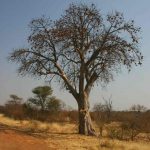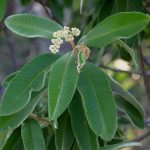TREE LIFE
JULY 1989
Is there a doctor in the tree house?
YES and our congratulations to Kim Damstra on being awarded his Doctorate of Philosophy (PhD)
MASHONALAND CALENDAR
Saturday 1st July : Botanic Garden Walk, meet in the car park at 10 45 hours for 1100 hours. We shall continue with FABACEAE.
Sunday 16th July : An own cars outing to Mr. J. Danckwerts farm Chedgelow. This mystical spot will be know by many of our members who have attended out door musical concerts in a natural amphitheatre on Mr and Mrs John Danckwerts’ farm, Chedgelow. On the day that the recce was done Aloe chabaudii were in flower – what a wonderful sight. Sadly these will be past their best but Aloe excelsa might still be flowering. There is also a good variety of trees. We hope members of the Aloe and Cactus Society will join us once again.
Saturday 2nd July : Mukuviisi Woodlands Walk. Meet Phil at the Paget Road/Inyanga Cresceent gate at 1500 hours.
August 11th,12th and 13th Heroes Weekend : . Still in the Vumba, but now at Fallscroft Estate, serviced accommodation has been reserved for a few lucky people, if you would like to be one of them phone Maureen Silva Jones at work on Harare 739711. We are looking forward to meeting the Mutare district members. Details of venues will be in the next Tree Life.
MATABELELAND CALENDAR
On Sunday July 2nd : we go to Mayfair Dam, via Makovani Estate (Mrs J. Schur), Fort Rixon. Meet at Ascot Car Park at 0830 hours, lifts already arranged.
On Sunday August 6th we go to find a Euphorbia confinalis area, off the Figtree Road, then to Hendriks Pass and Silozwana. Meet at Grafotype, 81 Mafeking Road opposite Merlin at 0830 hours. Cars may be safely left there. Again an all day outing.
MATABELELAND NOTES
On Sunday June 4th we went to Mabukuwene, and had a very successful “Tree Bingo”, with a good turn out, so competition was keen. The winner, first to complete her card was Gail Walker. Young Georgina Eley earned second prize. One or two Trees expected, were not found, either because of drought or more likely we did not reach them, as we have to proceed in a fairly close group. In all we identified some 70 species in two hours. On the way home, inspired by the Chikwenya report, some of us went to see the only known Acacia albida in Bulawayo, also just starting to flower. It is on the old Railway Embankment off 12th Avenue, opposite the back gate of the Technical College. Among the 70 species were 5 Acacias, A.gerrardii, A.karroo, A.nilotica, A.rehmanniana, A.sieberana, many Aloe excelsa, Azanza garckeana, fruiting, Berchemia zeyheri, Bolusanthus speciosus, Canthium huillense, now Psydrax livida, Canthium lactescens, rather dry, Carissa edulis, Cassine matabelica, Catha edulis, Clerodendrum glabrum, Clerodendrum myrioides, Combretum mille, leaves reddened, Croton gratissimus, Cussonia natalensis, Erythrina latissimus, Euclea natalensis, Euclea undulate, Euphorbia ingens, Fagara capensis, now Zanthoxylum capense, Ficus capensis, now F.sur, Ficus ingens, Ficus sonderi, now F.glumosa,
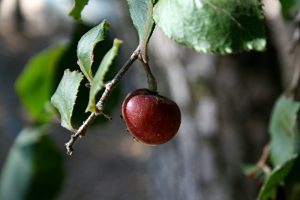
Flacourtia indica. Photo: Mark Hyde. Source: Flora of Zimbabwe
Flacourtia indica, many fruiting, Maytenus senegalensis, flowering, Mimusops zeyheri with fruit, Osyris lanceolata, a root parasite on figs, Pappea capensis, Pavetta gardenifolia, Pavetta schumanniana, Piliostigma thonningii, Pterocarpus angolensis, mukwa, Rhoicissus tridentate, Rhus lancea, Rhus pyroides, Rhus tenuinervis, Schrebera alata, Sclerocarya caffra, now S.birrea, Securinega virosa, now Flueggia virosa, Turrea nilotica with leaves less “drawstring” than usual, Ziziphus mucronata.
I make no apology for using some of the former names, as they figured on the Bingo cards, and will register better with the participants.
C. Sykes
BOTANIC GARDEN WALK, JUNE 1989
In the absence of some of our regular members (Kim was being “doctored” we decided to look at some Eythrinas and Figs. Erythrina are ‘old world’ trees, and are found on all the fragments of Gondwanaland – Africa, South America, Australia. The species are readily distinguished by the seeds, all of which are different. We looked first at E.livingstoniana, the lowveld species, with its thorny trunk. This does not flower at these altitudes. The Figs all have milky latex, alternate leaves and distinctive stipules protecting the leaf bud. When these fall a characteristic scar is left at the base of each leaf. We saw all these features on the F. bussei that we studied, formerly F.zambesiaca. This occurs only in the Zambezi Valley and is such a spreading tree that it is often broader than it is tall. The leaves are large and markedly lobed at the base. F.vallis choudae, found only in the Haroni-Rusitu area has huge circular leaves. It is a tropical forest tree, needs water all the year round and develops a true buttress trunk. F.bubu (formerly F.sp.No1) is another rainforest species which has a scattered distribution and is found in Mozambique, Malawi and as far south as Natal. The tree we looked at had smooth, green bark, hard smooth leaves and lower branches that were dying off due to over shading. A hunt through the undergrowth revealed Dostenia plants from the Eastern Districts which have boat shaped pods. Each pod is actually an enclosed flower similar to the fig receptacles. F;thonningii with its aerial roots is reminiscent of the Indian Banyan tree. This is a forest species (and can reach a height of 50m in the Chirinda Forest) which tends to have long peteoles. F.sansibariea can be a huge strangler fig from the Chirinda Forest. Often the original tree dies leaving a chapel like void in the centre. This tree has huge figs borne on the main branches. We ended the morning by looking briefly at E.abyssinicca which was covered with red hot poker flowers and E.latissima which has apparently flowered this year for the first time in 23 years. Out thanks to Tom for his enthusiasm and patience.
Tessa Ball.
AGM RUWA COUNTRY CLUB : SUNDAY 21ST May 1989
Chairman’s Report
Once again it is my duty to report to Members on the affairs of the Tree Society of Zimbabwe.
Over the past year your Committee has attempted to arrange a programme of events that we hope has offered everyone an opportunity to enjoy trees and the bush, after their own fashion. The monthly Botanical Garden walks have had a more scientific bias and the Mukuvisi Woodland walks have offered those who, for a variety of reasons, do not wish to travel, an opportunity to walk through the bush and keep in touch with trees.
There have been outings over long holidays and weekends for those with the time and mobility to go farther afield and see trees not normally met with on the high veld.
I have left the monthly outings to last, as this exercise is the one that concerns your committee more than any other, more particularly in one respect – that is, transport. Hiring buses is always something of a gamble in that we invariably require a minimum number of passengers to break even. At this point in time we have succeeded in doing so, but we are watching the situation closely, and may have to review this aspect of the operation in future. I would like to take this opportunity to appeal to members to make a special effort to support the outings that entail bus travel.
The monthly newsletter “Tree Life” is regarded by your committee as being a vital link that keeps all members, many of whom live too far away, to join in the various outings, in touch with Society events. In addition we try to make it informative and entertaining. However the inflationary situation in which we live has crept up on us and this leads me conveniently to the next problem, subscriptions.
During this year we have combined our outings with other Societies on two occasions, the Aloe and Cactus Society and the Pre-history Society. This has proved to be successful, and I think all those who attended these outings picked up some refreshing new aspects of the natural wonderland in which we live. It is your Committee’s intention to do this again when suitable opportunities arise.
Your committee has also laid the foundation for a tree mapping exercise designed to up-date existing records especially with respect to sub-species. We are still awaiting the record cards and tree lists, and when these come to hand the help of all members will be sought to get this project off the ground.
On a personal note, I would like to express my appreciation to the Committee for their hard work and support over the last year. It has made the job of chairman most enjoyable. I would also like to thank Mark Hyde for leading the Mukuvisi Walks so effectively. Tom Muller for taking us around his gardens and Kim for readily sharing his wide knowledge and sense of fun during our various outings. Kim must be congratulated on his Zambezi Valley Leaf Key which leads one unerringly to the identification of what he or she is looking at. This must be the most important contributions to tree identification in the decade that is nearly history.
Finally I would like to express the thanks of all members to the landowners and farmers who invariably make us most welcome and without whom we would soon become a Society without trees.
After the meting we spent a pleasant hour examining the trees on the golf course near the club house before assembling in Ant and Jen Hardy’s pretty garden for lunch. After lunch we rambled briefly through the woodland near the homestead before returning to Harare.
TRANSPORT FOR OUTINGS
Some discussion took place at the AGM concerning transport of Harare members on outings. On several occasions during the last year the cost of hiring a bus has barely been covered by the number of passengers. There can be no question of covering a shortfall from general funds, and so the whole question of the provision of buses must be examined.
The Committee would like to hear ideas on how the provision of buses can be continued at a cost that is reasonable. Suggestions already made include –
- reducing the number of bus outings, and combining these with members of other societies
- reducing the fares in the hope of attracting more travellers to bring the total income up to an amount that will cover the bus hire
- doing away with bus outings altogether and rely upon members sharing cars
Please let us have your views either in writing to P.O.Box 2128, Harare, or by telephone to any Committee member. These are listed below:
Dick Hicks 302252 Phil Haxen 702561
Kim Damstra 35757 Joy Killian 725576
Maureen Silva Jones 739711 Vida Siebert 706821
NEWS FROM AYRSHIRE
Outing to Gomo Estate by kind invitation of Ian and Margaret Barron – May 14th 1989
It was a warm sunny morning and tea was served in the garden. Our host have an introductory talk and showed us the aerial photograph of the estate. He has continued his father’s policy of preserving indigenous vegetation.
At the time when Fred Barron developed the farm for breeding Mashona cattle and crop production the survey maps of that era had explanatory symbols for every square yard of vegetation or lack of it. When he chose area to be cleared for ploughing he made sure that no land could be seen from another land. Progress has brought the metricated map which does not provide this information, it is lifeless without an aerial photograph.
Ian pointed out the angular shapes of woodland and vlei, they are continuous. This brings to my mind what Stan Fourie, our local ornithologist and ex chairman of the Ayrshire Branch of the Tree Society, said about birds of Miombo woodland. They will breed there if the woodland is continuous and not less than a certain number of hectares, this figure eludes me but the OAZ people will know. Gomo is largely Miombo woodland.
The expedition began. Ian drove the tractor – we travelled on a very well appointed trailer which had wired sides, a stepladder for access and hay bales to sit on. The party consisted of two little boys belonging to Sue and Dave du Plessis, 2 Duffields, 3 Hendersons, Dick and Maureen from Harare, Ann Hatley, Paul Zwanikken and the writer, who is very sorry if this list is not complete. Margaret Barron followed in the car so as to be prepared for the unexpected.
Tree-ing along the route was easy and it was as Ian said, “every land comes as a surprise!” We crossed the Suzuje river and stopped at the top of the ridge to see Boscia salicifolia which has soapy bark and edible roots. The latter may be used for porridge or coffee by the villagers, depending on the way it is prepared, and also has medicinal uses. These uses are listed for B.albitrunca, in the absence of which, B.salicifolia may supply these needs. The local Botanical Dictionary indicates that the word ‘murunganyama’ describes several trees which have the same use. Around here B.salicifolia provides a medicinal porridge. The walk started from a place which Ian called the cathedral. The walls were granite, the living pillars and arches were Pod Mahogany (Afzelia quanzensis) and Pittosporum, here in the cool shade we left our bread and wine hoping that God’s tiny creatures would not partake of it before we returned.
The going was good and we covered a lot of ground along wooded headlands and on a mowed path beside a vlei where we found Crossopteryx febrifuga and two of the common species of Protea. It is remarkable how similar is the wood of Protea spp Faurea spp and the exotic Grevillea sp. this is evident when termites have been busy on a living tree; it emphasises their relationship as all are members of PROTEACEAE. A lavender tree,
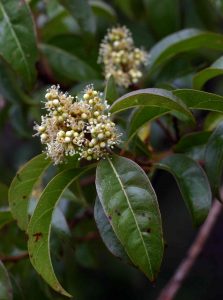
Heteropyxis dehniae. Photo. Bart Wursten. Source: Flora of Zimbabwe
Heteropyxis dehniae was undamaged amidst the grazing cattle, Mashonas. Then the pace slowed as we came to a great variety of vegetation at the foot of Guinea Fowl kopje, hereabouts several samples were bagged to be identified in Harare. The little plant with red glasslike berries bore simple leaves with numerous raised dots on the upper surface. We thought it must be a species of Pavetta, does anyone know? (Yes – Pavetta radicans – Ed). Higher up small trees grew to a great height on this side of the kopje which had a south-easterly aspect. Maytenus undata towered above us. Erythrococca menyharthii was there (Paul Z. and the writer have found a totally mottled foliage version of this, the variegation due to sucking insects or disease?). This was located not far beyond the point where we turned to descend on a previous visit, and where we found Holarrhena pubescens, Jasmine tree, in full fruit in February. One flower produces 2 pods, follicular carpels, the leaves are simple, large and glossy and the plant is a joy to behold, especially when it is flowering.
Dick Hicks has already mentioned this excellent day at Gomo where 105 species were found. We do not often see Apodytes sp. and we were pleased to see it in Ayrshire. Trevor Gordon probably introduced it to us when he led a walk to the source of the Susuje river in the Great Dyke on Lone Cow Estate, Mutorashanga.
The sum of trees and shrubs found and recorded on a field card for Gomo dated 3rd April 1979 added to those ticked on 14th May 1989 totals 122 species, no doubt there are many more waiting to be found. This total reflects the increase in botanical knowledge by members of the Tree Society and others. As learners we are grateful to the staff at the Herbarium and the contributors to Science News and Tree Life. Furthermore we are fortunate to have some good reference books which make botany homework a rewarding pastime.
Thank you Ian and Margaret for a delightful day, we hope you enjoyed it as much as we did.
-Benedicta Graves.
A REMINDER
If your Tree Life does not arrived timeously next month please do not blame the postal authorities until you have checked whether your subscription has been paid.!!!
CHIKWENYA NOTES – MAY/JUNE 1989
The Acacia albida (Faidherbia) are still flowering and on some of the early individuals the apple ring fruits are beginning to show. We have been amazed to see the first flowers of the climber, Combretum paniculatum, deep scarlet sprays showing at the tops of the A.albida host trees; this is very early as the main flowering is in spring. We have found some susage trees, Kigelia africana, flowering early, and a Cassia abbreviata with bright yellow blooms. The
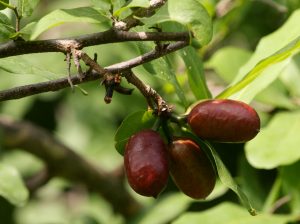
Cleistochlamys kirkii Photo: Bart Wursten. Source: Flora of Zimbabwe
Cleistochchlamys kirkii are already covered with tiny round flower buds, presumably these will stay much the same for a while, now that the cold weather has finally arrived, and then burst out into flower with the warmth later? Friesodielsia obovata and Diospyros senensis still have fruits on them, but they are being well harvested by the birds and the baboons. The pods of Afzelia quanzensis, the pod mahogany are beginning to split and drop the big bright black and scarlet seeds. There are fruits on the Oncoba spinosa, the snuff boxes, which make good rattles. The Tamarindus indica are still very heavily in fruit. The round green fruits of the Boscia mossambicensis are now showing through the wispy dried remnants of the autumn flowers.
Kim visited, and found for us a ‘wishing tree’ – two adjacent Commiphora karibensis whose branches have fused to form an archway – wishes made underneath are guaranteed?
EB/VS/JS/DW
I was fortunate to visit Chikwenya with my father and Stretch Ferreira this month. Travelling along the ‘middle jesse’ road that links Mana Pools and Chikwenya we saw many Maerus kirkii in white flower. Their large dark green leaves have stiff hairs on the top surface. As with many other members of the CAPPARACEAE the leaves are hard and become brittle, they also have a prominent midrib along the under surface. The Combretum celastroides along this road are turning red to plum and form a colourful display. I was delighted to recognise Hugonia orientalis in the thick bush between Chikwenya airstrip and the Sapi River crossing. I had not seen it in the Valley before although it has been reported. There were none of the distinctive ram-horn tendrils that we saw at Gona re Zhou but the new buds are large and distinctive with prominent ‘antler-like’ stipules and the leaves are often serrated. While on a wood run with Elspeth we examined the ecotone between mopane woodland and jesse bush and discovered a ‘wishing tree’ formed by the fusion of two adjacent specimens of Commiphora karibensis’s. These two trees thus form a continuous arch under which one may walk and wish. We may remember the well known wishing tree on the Bayley’s farm at Mount Hampden where the arch is formed by two adjacent fig trees. I believe wishes play an important role in self assessment. They verbalize inner desires that are often somewhat whimsical. All my wishes asked of these trees have materialised, but once granted the wish is seldom as satisfying as imagined. Wishes, if remembered, highlight our need for goals that seem unattainable but show us that there is greater satisfaction in striving than in the actual achievement. It was good to see the magnificent Commiphora ugogensis in the jesse around Chikwenya. This species has a rich copper trunk with purple zig zag branches, it is relatively rare in the Rifa Triangle but here it seems to replace Commiphora caerulea. As with most of the Commiphora species it is already leafless. Most of the Kigelia around Mana and Chikwenya are devoid of fruit this year although many specimens along the Harare – Beit Bridge road are laden with sausages. The late rains in the Valley may have resulted in abortion of the young fruit in November last year. Veronica Stutchbury had collected seed pods from the Albizia brevifolia that grow along the river cliffs along side the Sapi River, these trees are as attractive when in fruit as they are in flower. There is still a lot of water in the pans away from the river and the road between Chikwenya and the Sapi river skirts around shallow pans filled with water lilies in full bloom.
Many thanks to the Chikwenya folk for their write up and hospitality.
DICK HICKS CHAIRMAN


